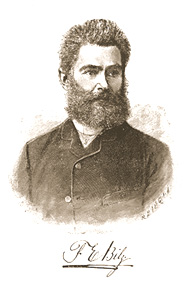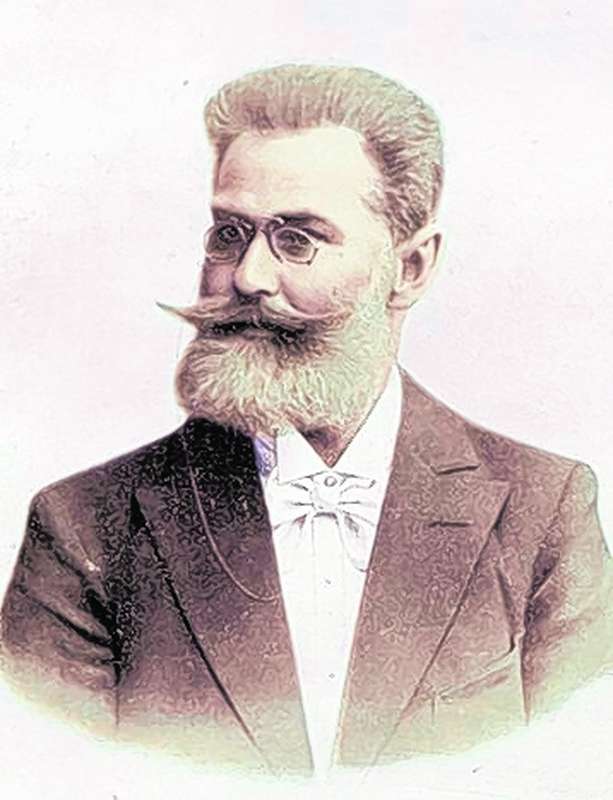Friedrich Eduard Bilz
Friedrich Eduard Bilz ( born June 12, 1842 in Arnsdorf b Penig; . † January 30, 1922 in Radebeul ) was a German naturopath and health reformer. He is also referred to as the father of popular naturopathy. His books have achieved a circulation of 3.5 million copies and have been translated into twelve languages. After his death he was buried just to the right of the tomb of Karl May, with whom he was acquainted.
- 6.1 Health Facilities
- 6.2 fonts 6.2.1 Bilz- book
- 6.2.2 Social fonts
- 6.2.3 narrative aspect works
Life and work
Bilz made 1856-1859 apprenticeship as a weaver and settled after a period of wandering in 1860 as a weaver in Meerane down. Until 1867 he worked as a weaver in a factory. Due to the poor working conditions in the factory suffered Bilz stomach cramps and was suffering lung. Bilz learned the Meeranerin Marie Auguste know, daughter of Johann August Webmeisters Kreil, whom he married in 1868 after the birth of daughter Marie Lina. Then Bilz worked independently with a family weaving.
After buying a house for the family by the father Bilz opened there in 1872 Alba Road 18, a grocer's shop. He gave up weaving and was a grocer.
In the same year 1872, there was a smallpox epidemic. Meeraner citizens who did not consider arranged vaccinations as adequate health care, founded the association for health care and naturopathy, which also Bilz member was. The association held lectures and courses from the natural medicine. However, because many books were incomprehensible because of the use of foreign words, Bilz collected all understand instructions to healthy lifestyle and medical treatment. While his wife successfully led the profitable store and took care of the family, Bilz tried many of the instructions to be yourself. Self-taught, he acquired so that the natural healing and became gradually a nature-based belief. Due to the revenue of the grocery store financially secure, Bilz wrote his first book The human happiness. A guide to health and prosperity by returning to natural law. Family friend and family treasure for healthy and sick. At the same time a contribution to the solution of the social question, which appeared in 1882, self-published.
Next came " The key to the full human happiness or reverse the law of nature ." The Chemnitz manufacturer and patron of naturopathy Johann Zimmermann proposed to revise the naturopathic Annex and publish as a standalone book. This resulted in 1888 the book " Bilz, the new healing method, a reference book for everyone in healthy and sick days. "
The plant popularly called short Bilz book was called in the following editions "The new therapies. Textbook of nature-friendly way of healing and health care. " In the same year founded the publishing Bilz F. E. Bilz. The Bilz book was known beyond Saxony quickly. The secret of success lay in the simple explanation of complicated medical issues and in the understandable and in every household to practicing healing recommendations. 1925 were more than 2.5 million copies sold, and also launched the book in 12 languages.
1889 gave the family to the grocery store and moved to Dresden, 1890, after Oberlößnitz, now part of Radebeul. There he had bought the estate of the Vienna privateers Richard Strubell on a section of the vineyard Albert hill above the house Albert Hill, where he in 1892 in the existing neo-classical building a small sanatorium for its natural sanatorium (later Kurhaus I) for initially 15 patients opened ( Bilz- sanatorium ).
Since this building soon became too small, let Bilz until 1895 following the Kurhaus I eastwards the Kurhaus II building, the so-called Castle Lössnitz. In the same year he bought also the property Jägersberg added from the Hantzsch villa was home Bilz. From 1896 the bathhouse ( Kurhaus III), to the north behind the Kurhaus II in the 45 degree angle, grown and 1898/1899 IV taken at the nearby Hunter Mountain the Kurhaus in operation.
1898 drew the Bilz -Verlag, which was conducted since 1893 by Bilz ' son Arthur Ewald Bilz ( 1872-1941 ) to Leipzig by 1899 a branch was opened in Paris and 1900 in London.
1902 Bilz developed together with the Lippe merchant and drinks expert Franz Hartmann The Bilz -Brause, from the 1905 Sinalco ( sine alcohole = without alcohol) was.
In 1905 he opened above the ground Loessnitz the Bilz- light -air bath ( Bilzbad ). Meanwhile line received 1906 Bilz ' youngest son Willy John Bilz ( 1884-1965 ) and his wife Margaret Ottilie, during which his eldest brother Max Alfred Bilz ( 1877-1939 ) had already succeeded as director of the sanatorium since 1905. Since 1906, the Bilzbad had 1,000 dressing rooms. From 1912, it was under the name Undosa - wave known, due to the installation of the Undosa Wave Machine ( Undosa in German translation: " the wave rich "). This first wave machine in 1911 was presented at the International Hygiene Exhibition in Dresden and immediately purchased by Bilz. The wave pool can still be used today.
Published in 1907 Bilz a science fiction novel (in a hundred years ) of 1130 pages, which plays in the year 2048 and in the Bilz sees fulfilled its political, social and Lebensreform ideals. Unlike his naturopathic books this utopian novel no success seems to have been brought. He found no more widespread and fell completely into oblivion.
Friedrich Eduard Bilz died on January 30, 1922 at his home and was buried at the place right next to his longtime friend Karl May in the cemetery Radebeul -Ost. The listed today, consisting of stone and cross simple tomb has the inscription "Nature was my guiding star ."
Bilz products
Bilz -Brause
In addition to his books FE Bilz was also supported by a soft drink, the Bilz -Brause (actually Bilz ' shower ) well beyond the borders of Europe known.
In 1900, the Lippe merchant and drinks expert Franz Hartmann had turned to Bilz. He traveled with the recipe for a lime extract after Oberlößnitz. The idea appealed Bilz, since in his opinion the mineral salts and fruit acids contained in fruits are healthy and the fruit sugar weitergäbe its energy directly to the blood. Bilz and Hartmann developed so from tropical fruits and native fruit species a natural fruit drink, the " Bilz Limetta ", which was named in May 1902 as " Bilz -Brause ".
1902 a large advertising campaign was launched with the success that the first international, non-alcoholic beverage brand of European origin established. Quick there were also imitators. Around 1905, there were discrepancies between business partners, and from then on, Franz Hartmann decided to look for a new name for the " Bilz -Brause ". A competition brought forth the name Sinalco (Latin sine alcohole - without alcohol).
Even today, the name " Bilz " in Chile is used for a red shower, but goes back to one of the generic products had emigrated to Chile Bavaria Andres Ebner Anzenhofer.
More Bilz products
The convinced naturalist and resourceful entrepreneur Health Bilz developed and marketed a number of other products which should support his health philosophy. Such " reform - nutrient " for example, were Bilz- nutrient salts, Bilz Nährsalzkakao, Bilz- nutrient salt and chocolate Bilz -malt coffee.
The friendship between Eduard Bilz and Karl May
Eduard Bilz was reader and friend of Karl May The connection began no later than 1896, when Emma May, Karl May's first woman in autumn recovering from influenza for several weeks at the Bilz Sanatorium. For later there is evidence that May along with Clare, his second wife, took part in the annual Rose and wine festivals, which gave Bilz for spa guests. In 1907, May made itself a cure at the Bilz Sanatorium. On a wedding photo of a Bilz daughter of 1907 can be seen sitting side by side the couples May and Bilz.
Bilz was a limited partner of the company " Ustad film, Dr. Droop & Co. ". This company produced in 1920 May- three silent films.
Karl May in turn took Eduard Bilz as a model for the " former barber Hermann Rost" in the band from 1897, " Christmas! ": " He is now one of the most respected doctors of the East and nature ... a reader of my travel tales. "
Honors
Since 1935, carries a road in Radebeul his name until the end of World War II it was today August Kaden Street. Since 1945 is today Eduard Bilz road from one part of the former Strakenwegs to Augustusweg, from there, the former Sophie street from the crossing Nizzastraße the former Gabelsbergerstraße to trans- Meißner Straße and south of the Meissner Strasse, the former Luther Road. In 2002, the space at the intersection Eduard Bilz- road with the Augustusweg ( the former King 's Square) in Eduard Bilz Square was renamed.
There on the Eduard Bilz- space is the Bilz- stone today.
The three cities Burgstädt, Lunzenau and Penig in the vicinity of his birthplace Arnsdorf created the Bilz health and active region and has a Bilz Trail, a cycle route Bilz and a day of health.
The high school in Penig bears the name of Friedrich Eduard Bilz.
Bilz Association
The Bilz Association of Natural Medicine eV was founded in 1995 in Radebeul, the city of the interaction of Friedrich Eduard Bilz. He has set himself the task of reviving the tradition of natural healing in the sense of F. E. Bilz for today's modern time and make known, since the topic was concealed in GDR times.
The five classical columns naturopathy nutrition therapy, exercise therapy, hydrotherapy, phytotherapy and order therapy be scientifically oriented revived and taught their application. The head physician of the Bilz- collar connected is a specialist in general medicine, naturopathy and homeopathy. She has from the State Medical Association Saxony authorizing the medical training for the additional term " naturopathy ".
Work
Health facilities
- Bilz Sanatorium in Oberlößnitz, today Radebeul, with large outdoor and walking terrain Castle Lössnitz in Oberlößnitz, former wellness II of the Bilz Sanatorium
- Hunter Mountain in Oberlößnitz, former wellness IV of the Bilz Sanatorium with large outdoor and walking terrain and private residence ( house Bilz )
Writings
Bilz- book
- Friedrich Eduard Bilz: The new healing method. Textbook of nature-friendly way of healing and health care. Publisher F. E. Bilz, Dresden, 1888.
- Friedrich Eduard Bilz: The new natural remedies. Teaching and reference book of nature-friendly way of healing and health care. Publisher F. E. Bilz, Dresden, Radebeul. 20th edition 1894.
- Friedrich Eduard Bilz: The new natural remedies. Teaching and reference book of nature- life and way of healing and modern health management. With 3 fold folded plates and with many partly colored illustrations. 2 vols. Anniversary edition. F. E. Bilz G.m.b.H. Verlag, Dresden -Radebeul 1938.
- Friedrich Eduard Bilz, Hans Balzli: Natural healing methods. Reference book of nature according to the life and way of healing; with a folding colored plastic model of man. Keyser, 1956.
Social writings
- Friedrich Eduard Bilz: Human life happiness. A guide to health and prosperity by returning to natural law. Family friend and family treasure for healthy and sick. At the same time a contribution to the solution of the social question. Self- Verlag, 1882.
- F. E. Bilz: The Natural State. Proposals for a nature-friendly legislation. By meeting the same would today's mass poverty, which is particularly severe impact on Germany, will be fixed soon. 1st - 20th Thousand ( First Edition ), FE Bilz, Leipzig, Dresden -Radebeul, 1922.
- Friedrich Eduard Bilz: The key to human happiness or full conversion to the law of nature.
Narrative works
- F [ riedrich ] E [ Duard ] Bilz: In a hundred years. Richly illustrated novel. Leipzig, Dresden -Radebeul: Bilz, 1907 Digitized edition.










